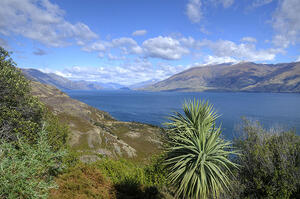
Pests and weeds in Otago
Otago is home to some of New Zealand’s most celebrated lakes and rivers including the Kawarau River, Lake Wānaka, Lake Wakatipu and Lake Dunstan.
Many of these waterways are under threat from aquatic weeds such as lagarosiphon, which can choke waterways and smother native aquatic plant and fish life. It spreads quickly and left untreated ruins lakes for activities such as swimming, fishing and water skiing.
The shorelines of these areas are also impacted by non-native weeds including for example wilding conifers and non-native brooms.
Tackling the problem
Our annual aquatic works programme aims to control the spread of lagarosiphon at key sites in the region’s major lakes and waterways according to the level of infestation.
Successful and sustained control work in Lake Wānaka means we now look forward to reaching the point where only maintenance control work is required.
Lagarosiphon is widespread in Lake Dunstan so on this lake we focus our biosecurity work on areas most used for recreation.
To retain the use of lakes and rivers and restore native plants, fish and birds we use a range of well tested methods to control weed growth, in line with strict consent requirements.
This includes scuba divers hand weeding to remove invasive plants, the installation of biodegradable hessian matting which supresses weed growth at the same time allowing native plants to grow through, and the application of very low concentrations of the herbicide Diquat to weed infested areas.
Our work managing terrestrial weeds across Central Otago ranges from targeted operations such as removing a stand of wildings to weed management around the shoreline of Lake Dunstan.
Working with others
Pests and weeds don’t recognise personal or property boundaries, so we coordinate closely with Otago Regional Council, Queenstown Lakes District Council and Central Otago District Council to ensure our on-the-ground biosecurity control operations get the best results.
How you can help
All lake and river users also have a role to play in stopping the spread of water weeds. If you’re moving between waterways, you must clean all your gear using the 'Check, Clean, Dry' method. This stops plant fragments moving between waterways, which can be all it takes for a new infestation to begin.